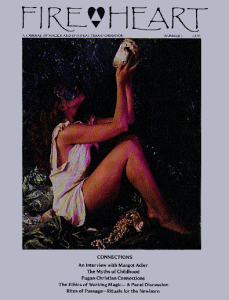 Rites of Passage
Rites of Passage
Celebration of Birth
by Sue Curewitz Arthen ©1990
Once, there was born a baby who brought such joy to her parents that they could hardly contain themselves. In celebration of her birth, they prepared a great feast, and invited all their friends, relatives, and the wise folk of the area to attend. At the end of the feasting and merriment, each of the wise folk made a wish for the baby. The first wished her kindness, the second wisdom, the third beauty. Another wished her virtue, another tenderness, and so on – everything a child could possibly wish for.
This lovely image of a baby blessing comes from the German folktale, The Sleeping Beauty, and many Pagan and Craft baby blessings have a similar quality about them. Everyone gathers around, offering things sweet and light to the little one, while qualities of strength and power, if mentioned at all, are referred to in the mildest of terms. What is our intention in raising this magical energy? The answer must go deeper than “good wishes” when the central figure in this ritual is a revelation of the most profound mystery we know of.
Most books on Paganism and the Craft contain few references to baby blessing, wiccaning, or saining, which are the three most common terms for rituals that focus on the newest members of our community. Of these, baby blessings are the most common, and are done specifically to bestow good wishes on the newborn by members of his or her community. The blessings are deliberately neutral, aimed at the baby alone rather than making a connection with the spiritual aspects of the birth/death/rebirth cycle. This may, in part, be the parents’ way to avoid “imposing” their religious beliefs on their child. in many ways, we have not come to terms with how firmly our childhood religions were forced on us. In our determination to avoid that imposition on our own children, we often create rituals that are neutral – devoid of any intensity or power.
The origin of the term wiccaning to describe the ritual for the newborn is unclear. It may perhaps be an adaptation of the Christian term christening, and is used in the Wiccan traditions of the Craft such as the Gardnerian and Alexandrian traditions. At a wiccaning, the baby is presented to the four elements and ritually anointed with oil or water. Godparents pledge to guide and protect the baby through childhood. Unlike christening, wiccaning does not commit the child to any one path. According to Janet and Stewart Farrar in their book, Eight Sabbats for Witches, it does “invoke Divine protection for the child and ritually affirms the love and care with which the family and friends wish to surround the newcomer” (p. 155) The Farrars, in their work with wiccanings, tried to avoid confusion with Christianity by substituting the word sponsors for Godparents, but they disliked the coldness of the word, and, instead, reclaimed “Godfather” and “Godmother” for Craft use.
The term sain comes from the Old English segnian, meaning to mark with a sign. It eventually came to mean “bless.” Saining is a traditional European child blessing and naming that takes place within the first nine days after birth. Often, the baby is taken to a grove, where a tree is chosen or planted. This tree will stand witness to the first utterance of the name by which the child will be known. The name is traditionally spoken by the mother if the baby is a girl, or by the father if the child is a boy. A magical name may be chosen as well, and this is whispered into the baby’s ear, but is not made public. The child is passed around the circle to be introduced to friends and family, who may give offerings, presents, or wishes. The child’s name is then spoken to the four directions. Sometimes, the baby’s umbilical cord is tied to a branch of the tree as a connection between the child and the tree, and the placenta is buried at the roots of the tree to nourish it.
For most of human history, the process of birth has also been associated with death, and in many countries, that is still a reality. Childbirth is seen as a threshold in life that often puts those experiencing it or those close by in danger. For this reason, the newborn, and often the mother, are considered taboo until a specific ritual has been done to release the taboo and purify the mother and child. Examples of this belief can be seen in many cultures. Polynesians consider the child “tapu,” and it is cleansed first by the father, who touches it with a roast fern root, which he then eats. This procedure is then repeated by the eldest female relative. Among the Zunis, a sponsor breathes on a wand, which is extended toward the child’s mouth as she receives her name, The Maoris of New Zealand wait while a priest repeats a number of ancestral names until the child sneezes, at which moment the name being spoken is bestowed and the child asperged or dipped into water. In the Guban tribe, a crier announces the birth and claims for the child a name and place among the living, while some member of the community promises that the child will be received and have a right to all tribal privileges and immunities. The birth of a child into these tribal cultures requires three formal actions: cleansing, naming, and formal acceptance into the community. It is among these cultures that the use of water (which was considered alive) to cleanse and purify was first established. Water’s ability to cleanse away dirt meant that it could also be used to cleanse material or spiritual evil. The Mayans, for example, believed that the ceremonial ablution washed away evil, and the Aztec ritual for newborns starts “O child, receive the water of the Lord of the World which is our life.”
In America today, most “purifications” happen at the hands of the delivery room staff. Naming, which may be the result of lengthy deliberation, runs the gamut from family names to names that will imbue the baby with seeds of power and success. Acceptance into the community can consist of mailed announcements, mainstream religious rites of circumcision or baptism, or informal “welcoming” parties. Although a great fuss is made over babies and their birth, and a great many marketing dollars are aimed at convincing new parents that tons of equipment, stimulating toys, varied outfits and video cameras are necessary if one is to be a “good parent,” children today are often cast in the role of a product – a reflection of their parents, rather than being regarded as an asset or a pledge to the future.
Many societies, and many Pagans, wait to do naming ceremonies until suitable astrological events occur, or until a specific sign in nature manifests. In fact, the child’s “true” name may not be known right away, and in that case, a naming waits. In societies where infant mortality is high, a child may carry a baby or “milk” name, and is not considered a formal member of the community until it is weaned, until its second birthday, or until it can walk.
What are Pagans trying to do when we celebrate the birth of a child? For some, a naming circle makes an intentional connection to the Sacred, and it is often the first time that the newborn’s name is spoken aloud. We try to connect with the circle of life that began with the first peoples. We experience a sense of timelessness in circles, and at a saining, it takes little effort to look around, to see the baby raised to greet the elements, the Earth and the Sky, and to know that for as long as people have grouped together, some version of this circle has taken place. At sainings, our intentions are bound to tradition, reflecting what adults have always wanted for their young – protection, acceptance, health, and a Oneness with the Universe.
Sainings are a way to strengthen the connection of family. Birth, a rite of passage that is very specific to the newborn, affects more than the child. We are all renamed in the process. We become mother, father, grandmother, other mother, and we add new energy and power to the hands joining generation to generation and neighbor to neighbor. It is a time to affirm that our relationships hold energy in the circle of our lives. We count on this energy and on these relationships, when we have joys to share and when we need help.
A circle introducing the newborn to the Universe is a way to remember that children are not “ours” not something we possess. They have separate destinies with their own reasons for being, and their own relationship, if they find one, to the Sacred. A saining circle is a way to mark the baby’s first passage between the worlds.
In America, we rejoice that our infant mortality rate is so low (although it remains much higher for minorities). We put a lot of effort into reclaiming the birth experience as a natural process that requires support, rather than treating it as an illness that requires excessive medical intervention. Because of this, we often fail to recognize that the threshold of death, even in America, is a real possibility as birth takes place, and we err in creating rituals that have no tangible or visible celebration of what is, after all, a Blood Mystery. As participants in rites for newborns, we need the chance to recognize those connections, even if in a purely symbolic way.
As a community, we may soon begin to build physical neighborhoods, or we may stay connected in spirit but not in space for many years. Our children are still a promise to the future. The amount and kind of energy we all put into the first circle of their lives has as much to do with us, their kin and community, as it does with them. For some of us, having children and believing in the future at all is an act of consummate faith, in the Universe and in each other. For others, the gut-wrenching effort to nurture in non-traditional ways takes courage and determination. For all of us, it is crucial that we understand that celebrating birth and naming is a place where we can restate that terrifying, exhilarating commitment to a larger “family” and to the promise of our own tribal future.
Many of us will never be directly involved in the conception and birth of a child. To give the best that we have to offer at a saining circle, to give a true gift to the babies of our friends, we need to participate actively – to touch the ability within ourselves to conceive, to nurture, and to bring to birth the potent force that connects us with this baby, which is the manifestation of a true mystery. Let us learn to give gifts of the soul, along with gifts of the heart and mind.
SUE CUREWITZ ARTHEN is a mother, bookkeeper, Elder and Priestess, and now writer of articles. She does all these things with a lot of help from her friends.
